This week the most exciting news in chess for me was that the American team got trounced by the Russians in the World Team Championship, 4-0.
Come again?
Well, the real news was the Ian Nepomniachtchi beat Sam Shankland, and while I would ordinarily make me very sad, in this case I’m happy because Nepo used one of my favorite opening variations! This proves that allegiance to an opening takes precedence over allegiance to one’s country or one’s friends. Give me liberty or give me death, but don’t make me change my openings!
Okay, let’s see what happened.
Nepomniachtchi – Shankland, World Team Championship 2017
Caro-Kann Defense
1. e4 c6 2. d4 d5 3. e5 Bf5 4. g4!? …
Here it is, my favorite move. I wrote a long series of posts about it a few years ago in which I called it the “Home Erectus Variation.” The idea was that 4. h4 is the Caveman Variation and this is even more primitive, so it should be called the Homo Erectus Variation.
However, the name has not exactly caught on. When I saw this game on chessgames.com, they called it the Bayonet Variation. I guess that’s a pretty good name. It would be embarrassing to tell people you play the Homo Erectus Variation.
My argument for this move was almost 75 percent psychological. When a player under master level plays the Caro-Kann, they are telling you that they are a wimp. They want to avoid a sharp battle. So this move is intended to take the battle directly to them in the most blunt fashion.
However, when you’re playing grandmasters there is a world of difference. I’ve never been quite sure whether the Bayonet Variation is 100 percent sound against grandmasters. For this reason it’s always interesting to me to see how they handle it, on the ultra-rare occasions when they play it.
4. … Be4!?
Sharp but I’m not sure that it’s best. I’ve noticed that GMs almost always play 4. … Bd7 here, betting that the weaknesses induced by 4. g4 will backfire against White in the long run. However, Shankland has a more brash style; he is trying to out-and-out refute the variation.
5. f3 Bg6 6. e6?! …
Already a surprise to me. In my series on the Bayonet Variation, I concluded that 6. Ne2 was the correct move order, followed by 6. … e6 7. h4. I did not think that 6. e6 was really a serious try for advantage for White. The reason is the other 25 percent of my theory of the Bayonet: White’s goal is to wreck Black’s kingside before he has a chance to castle. 6. e6 doesn’t accomplish that goal; I don’t see any problems for Black after 6. … Qd6. However, Shankland again reacts in a very Shankland way. He in effect tells White, “I’ll let you carry out your plan and show that it doesn’t give you anything.”
Interestingly, Shankland gave a lecture on chess.com where he talked about this variation, and he was very dismissive. He didn’t even talk about 6. e6, and after 6. Ne2 e6 7. h4 h5 he said, “Trust me, Black is better.”
I wonder if Nepo saw that lecture and decided that he could teach Shankland a lesson?
6. … fe?! 7. h4 Nd7 8. h5 Bf7 9. f4 e5!
This time I agree with Shankland’s move. Black has to play this move to free his game; if he allows Ng1-f3-e5, White will have everything he wanted.
10. fe e6
Time for a diagram.
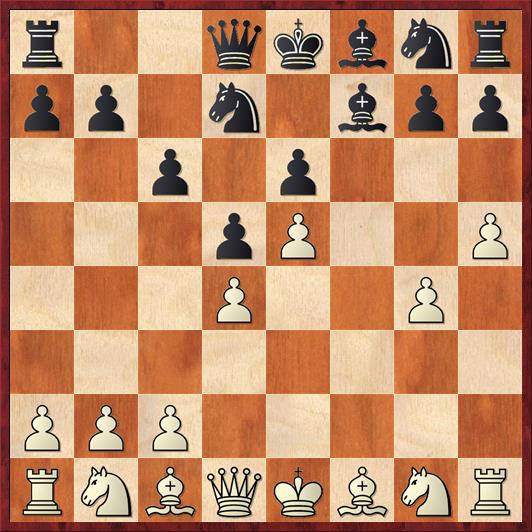 Position after 10. … e6. White to move.
Position after 10. … e6. White to move.
FEN: r2qkbnr/pp1n1bpp/2p1p3/3pP2P/3P2P1/8/PPP5/RNBQKBNR w KQkq – 0 11
My former teammate Larry Smith sent me this game by e-mail, because he was so amazed by the idea that a grandmaster would go 10 moves without playing anything but pawn moves. All of White’s pieces are still in their original positions! Not only that, White went on to win the game.
In my answer I showed him a game that I once played against Jeff Mallett, a strong expert: 1. e4 c6 2. d4 d5 3. e5 Bf5 4. g4 Be4 5. f3 Bg6 6. h4 h5 7. Ne2 hg 8. Nf4 gf?! (Too greedy.) 9. Nxg6 f2+ 10. Kxf2 hg (diagram).
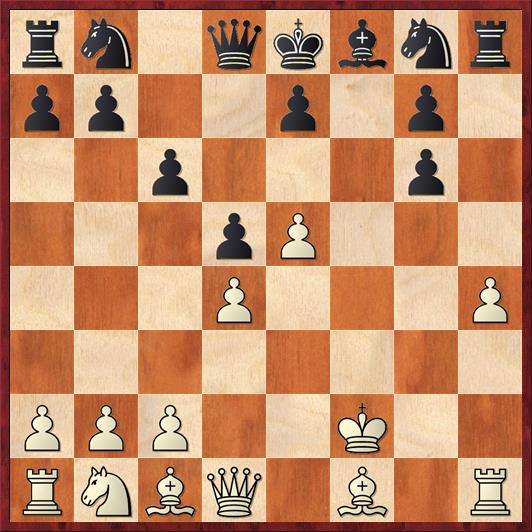 Mackenzie-Mallett, position after 10. … hg.
Mackenzie-Mallett, position after 10. … hg.
FEN: rn1qkbnr/pp2p1p1/2p3p1/3pP3/3P3P/8/PPP2K2/RNBQ1B1R w kq – 0 11
After 10 moves the only developed piece on either side is White’s king on f2! Within three more moves I already had a won game, as Black immediately blundered with 11. Qg4 Qb6?? 12. Qc8+. Now Black realized that 12. … Kf7 runs into 13. e6+. So he played 12. … Qd8, but after 13. Qxb7 I won pretty easily.
Okay, now back to the Nepomniachtchi game. After the first diagram above, there was a brief interval of sanity as both players brought out their pieces:
11. Nf3 c5 12. c3 Ne7 13. Bd3 Nc6 14. O-O Qb6 15. Kg2?! …
I read some analysis of this game on chessbase.com, and the commentator didn’t say anything about this move. Actually, given what happened next, it was possibly a critical mistake for White. If Nepo had planned the pawn sacrifice ahead of time, it would have been better for him to play 15. Kh1. That makes me think that we are in fact out of his pregame preparation. I think that he was just going on instinct.
15. … Rc8
Shanky resists the urge to take on d4, and instead strengthens his position. Rybka thinks that Black should play 15. … O-O-O with a comfortable game; the choice is a matter of taste. Now Nepo plays an extremely provocative move.
16. a3!? …
White continues to move pawns and not pieces, and offers the d-pawn again. Does White really have time to play so slowly? One can’t help but admire his sangfroid.
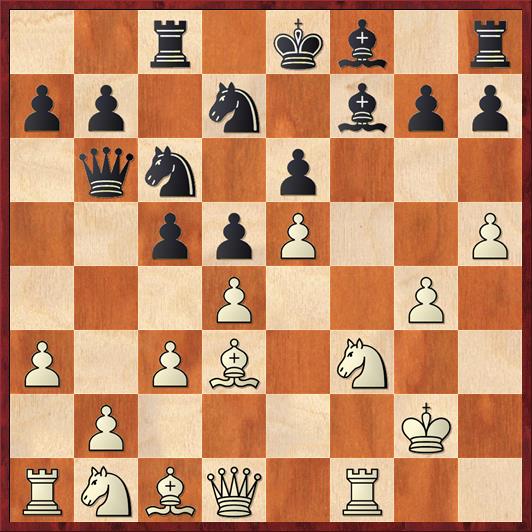 Position after 16. a3. Black to move.
Position after 16. a3. Black to move.
FEN: 2r1kb1r/pp1n1bpp/1qn1p3/2ppP2P/3P2P1/P1PB1N2/1P4K1/RNBQ1R2 b k – 0 16
16. … cd!
Now the game gets really exciting. Having played a developing move (15. … Rc8) that was answered by a non-developing move (16. a3), Shankland feels that he should be able to open lines and grab the d-pawn. And he’s right.
17. cd Nxd4 18. Nxd4 Qxd4 19. Bg6 …
Of course, this discovered attack is the point of White’s combination. It looks at first as if White is winning a piece. But the reality is more complicated…
19. … Qxd1 20. Bxf7+ …
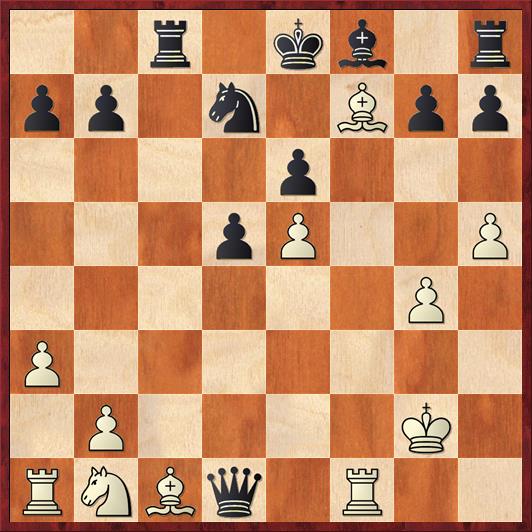 Position after 20. Bxf7+. Black to move.
Position after 20. Bxf7+. Black to move.
FEN: 2r1kb1r/pp1n1Bpp/4p3/3pP2P/6P1/P7/1P4K1/RNBq1R2 b k – 0 20
In these ultra-tactical lines you always wonder who miscalculated. Did Shankland miscalculate and think that he could get away with 20. … Ke7? If so, he missed the clever in-between move 21. Bg5+! when Black’s only way to avoid mate is to give up a piece with 21. … Nf6.
Alternatively, it’s possible that Nepomniachtchi is the one who miscalculated, and that Shankland saw deeper. Although Black is obliged to move his king to d8, the bishop on f7 is still trapped deep in enemy territory.
20. … Kd8! 21. Rxd1 Ke7!
A nice little two-step. Did Nepomniachtchi miss this?
22. Rf1 Rc2+
This is why White should have played 15. Kh1 instead of 15. Kg2! He has essentially given Black a free tempo to bring his rook to c2, and that should have been enough for Black to equalize.
Such subtleties are probably beyond human comprehension. However, this is the only misstep by White that I know of in this game, so he did pretty darned well in a very complicated position.
23. Kh1 Nxe5 24. Bg5+ Kd7 25. Nc3 Nxg4
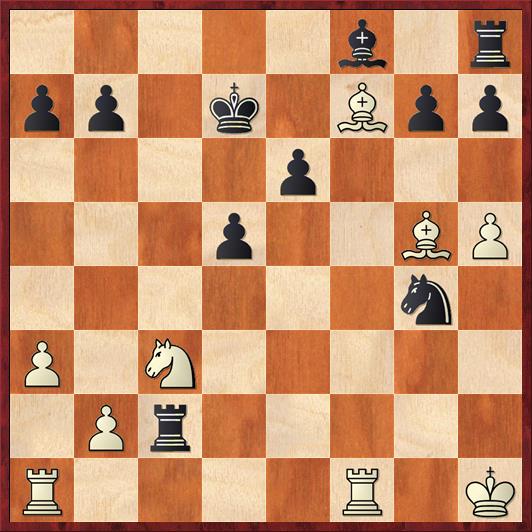 Position after 25. … Nxg4. White to move.
Position after 25. … Nxg4. White to move.
FEN: 5b1r/pp1k1Bpp/4p3/3p2BP/6n1/P1N5/1Pr5/R4R1K w – – 0 26
I have to think that Shankland probably felt pretty good about his position here. He’s got three pawns for a piece, another pawn is hanging, and Black has the huge threat of 26. … Rh2+ followed by 27. … Bc5+. But Nepomniachtchi comes up with an amazing resource. I can’t say enough about his resourceful play throughout this game, which is all the more impressive because Shankland is usually a guy who plays more creatively than his opponents, not vice versa.
26. Bxe6+! …
Seizing his one opportunity to take back the initiative.
26. … Kxe6 27. Rae1+ Kd6?
In this mind-boggling position, Shankland is the one who cracks. According to Rybka, the narrow path to equality went 27. … Ne5 28. Bf4 Bd6 29. Nb5 Rc4! 30. Nxd6 Rxf4! 31. Rxf4 Kxd6. Here Black has a knight and two pawns for a rook, the knight is very well centralized and one of the pawns is a robust passed pawn in the center. Black is perhaps not completely out of the woods, but he should be able to hold this.
28. Rxf8! …
Another pseudo-sac comes out of the blue.
28. … Nf2+
Shankland gets into the punch-counterpunch spirit, but unfortunately this is easily handled.
29. Rxf2 Rxf2 30. Nb5+ …
Again, it’s rotten luck for Black that he has nothing better than to allow White to take the rook pawn with a tempo. After 30. … Kc6 31. Nxa7+ Kc7 32. Nb5+ Kb8 33. b4 the smoke more or less cleared. Nepomniachtchi has two pieces for a rook and pawn, which is usually a significant advantage for the two pieces. Black still has drawing chances, because White’s h-pawn is weak and after it goes, there will not be many pawns left for White to win with. Nevertheless, Nepo played with great finesse and managed to win on move 69.
All in all, I think that Nepomniachtchi’s opening choice was psychologically brilliant. Although he did not in the end demonstrate an advantage for White, he posed enough difficult problems for Shankland to confuse the issue, and ultimately to win the game. It was very satisfying to me to see this variation played so well.



{ 4 comments… read them below or add one }
“he was so amazed by the idea that a grandmaster would go 10 moves without playing anything but pawn moves”
In fact this strategy is called ROT see my article http://chess-brabo.blogspot.be/2016/09/rot.html
I could make a lot of other comments about the game, but just quickly:
– Kg2 isn’t a mistake, as 22…Rc2+ and 22…Nxe5 are objectively roughly equal in value. After Rc2+ White should prefer 23.Kh3, but this is probably beyond the scope of human calculation – White would have had to see 23…Nxe5 24.Bg5+ Kd7 25. Nd2! Be7 26.Bxe6+! Kxe6 27.Rae1!! Bxg5 28.Nf3 and White is winning material.
– Nf2+ is a big mistake. 28…Rxf8! holds after 29. Be7+ Kc6 30. Bxf8 Nf2+ 31. Kh2 d4 32.Re6+ Kd7 33.Re7+ Kc6 34.Ne2 d3 35.Nd4+ Kb6 (only move) 36.Re6+ Kc7(only move) 37.Bd6+ Kd7 38.Bb4 Ne4+ with a perpetual. Sam had seen most of the lines here but thought that the game solution was simpler, missing that Kc5 was impossible after Nb5+. So Kd6 is not a mistake, even if Ne5 was a simpler solution.
First let me thank you for this great blog. I also bought “The Universe in Zero Words” and hope to enjoy it much (it’s still on the shelf).
Now about this article, it gave me lots of new ideas to face the Caro Kann and also inspire me to write an article on my own about the recent game between Paco Vallejo and Wesley So for round 3 of the FIDE World Cup, you can read it at http://www.captainchess.com/bayonet-attack-against-caro-kann-defense/
Thanks again.
Hi Yamil,
Glad you found my blog! In my opinion, the game Vallejo-So was a bit disappointing because Vallejo played e6 prematurely, allowing … Qd6. Maybe he was copying Nepo’s play without realizing that Black could handle it better than Shankland did.
{ 1 trackback }